Trading Networks
Individual adventurers
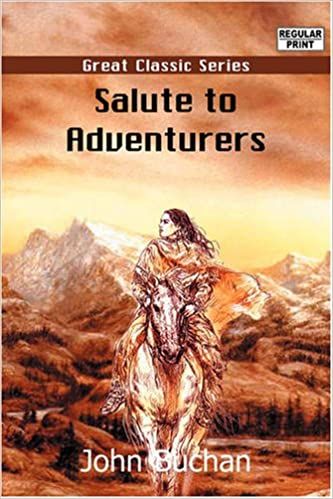
John Buchan's novel about a young Scottish North American trader is based on his reading and imagination rather than his direct experience. Nevertheless, as Governor General of Canada and friend of President Roosevelt, he promoted a greater recognition of the North American past in order to understand the present and to be inspired to make the future even better.
Young men (sometimes still in their early teens) who sought their fortunes abroad had to have great stamina and courage because they were facing challenges for which their childhood could not possibly have prepared them. It is unrealistic to pass off the pioneer spirit simply as a common trait of the Scots. It was, in most cases, a learned response to necessity.
As stories of the pioneers’ successes trickled back home some others were encouraged to make the leap. Usually, they were carefully chosen by those already at work abroad from a known pool of eligible local boys.
It is well worth pondering, as we read their personal biographies, what were their beliefs in self-determination, their family loyalties, their work ethic, their religious faith and their dreams of wealth that made the earliest pioneers take and manage all the huge risks involved.
Kinship and locality bonding
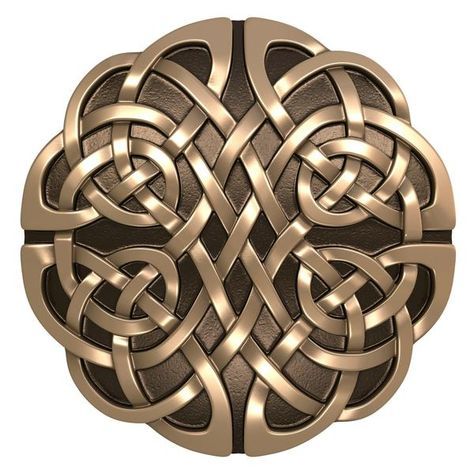
The Celtic knot can be interpreted as a symbol of eternal life in community that interweaves under and over all cultural barriers and religious divisions. It still inspires beautful jewellery, sculpture and embroidery. Was its message part of the heritage of the pioneers and their belief in the value of co-operative action?
Nepotism and local cultural bonding were, in fact, the necessary basis of survival and success for the entrepreneurs abroad just as they had been in co-operative farming on which this part of the country had relied for centuries.
These adventurers, however, were not colonizers or settlers out to form a community in a new land but explorers, exploiters and opportunists. They were adventurers in both senses of the word.
It is instructive to take the development of the North West Company of Fur Traders in Canada as an example of trade networking particularly since it was formed very largely by men from this region.
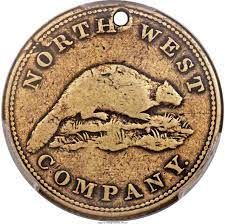
“At one time or another, there were on the NWC rolls, seven Simon Frasers. four Finlays, five Camerons, six MacTavishes, seven Macleods, eight MacGillivrays, fourteen each of Grants and MacKenzies and so many MacDonalds that they had to differentiate themselves by including home towns in their surnames, as in John MacDonald of Garth.
It seemed that every partner in the North West Company was blood relative to every other, most of them linking their family trees with that of Simon McTavish, the Company’s chief founder and guiding spirit. McTavish married a daughter of trader Charles Chabouillez, whose other daughter became the wife of Roderick MacKenzie, a first cousin of Sir Alexander MacKenzie. Simon McTavish’s nephew William MacGillvray, later the leading partner in the concern (joining his brothers Duncan and Simon), married a sister of John Macdonald of Garth, nephew-in-law of McTavish and a cousin of Patrick Small, whose daughter married David Thompson. McTavish had three nephews, two grand nephews, two brothers in law, three cousins and one distant cousin in the company.” James K. McDonell: Lords of the North
You will notice McDonell doesn’t even start to unravel the interconnections of the Grants and Camerons that so puzzled both Professor William Wallace and Elaine Mitchell who were, perhaps, the first people to research them and recognize their importance.
The two charts below are simply a preliminary mock-up of the main inter-relationships of the groups from Strathavon and Cromdale on either side of the Cromdale ridge. They linked with one another and with the Ballindalloch, Blairfindy, and Carron Grants and also with others from further afield so they are by no means complete. They will be replaced with clearer ones as soon as possible.

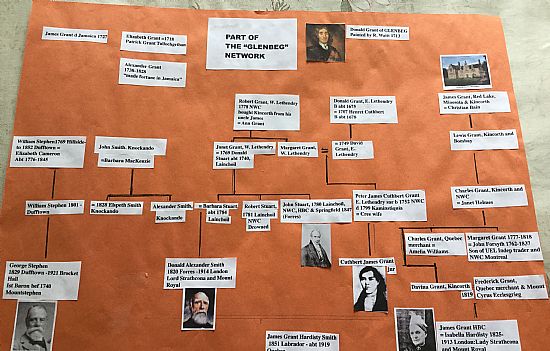
The Grants were, by no means, purely clannish. They intermarried with their close business associates, just as they had done previously within their farm towns, for the better success of their joint ventures.
McDonell notices that they married into French families with whom they worked and whose model of operation they had largely copied.
Country marriages with indigenous women are passed over, however, in silence and yet they were a vital part of the shared enterprise. Without their country wives it is certain that few of the lone traders could have survived in this new world let alone made a success of their trading ventures.
The sharing of the profits was rather less equitably distributed.
Multi-taskers
The Nor’ Westers were not simply administrators working in a depot. Taking responsibility for the sorting and dispatch of the pelts and careful record keeping was only a part of their job.
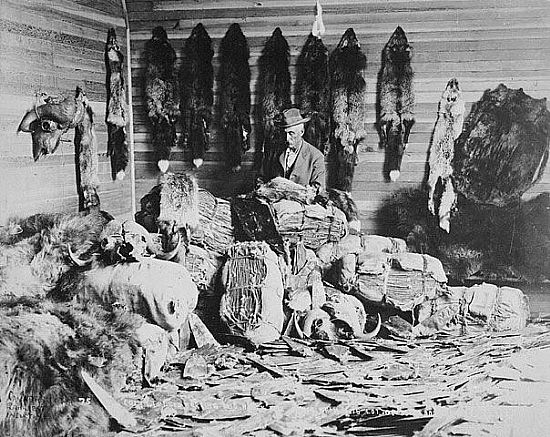
Eveb in the 20th century one of the fur trader's tasks was sorting and packing the pelts into bundles.
They were also active entrepreneurs who negotiated directly with the trappers.
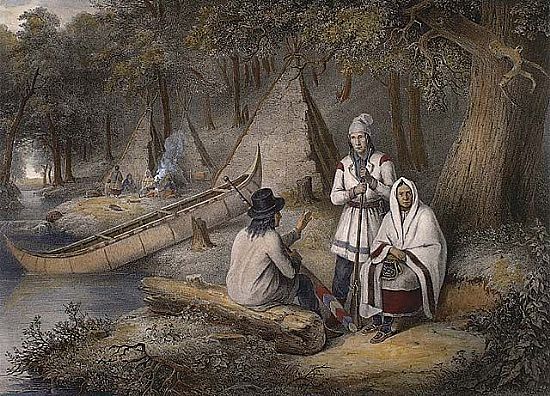
Many of the trade goods exchanged for pelts were seen as trinkets by the Europeans but in this painting it looks as though one of the most valuable was being offered in the long musket.
They transported goods over vast distances usually by canoe when the rivers were not frozen.
They were also hands on in the construction of safe accommodation, of the maintainance of canoes and fort management.
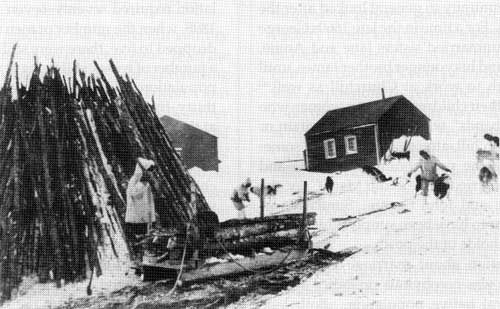
Winter at Fort Churchill as shown here was still hard even in later times when there were telegraphic communications but must have been much harder when there was no way of contacting the outside world.
Winters were harder and longer than even these hardy Scots were accustomed to. Then travel became impossible except for short distances by dog sled and they were isolated for months at a time.
Most became avid readers and kept a good library. Many wrote personal diaries though sadly only a few have survived.
They worked hard and when they got together for their annual rendezvous they shared their experiences, their profits and plans for the future. They also competed in sports and games and, in the evenings they dined, danced and drank themselves into oblivion.
They had to have extraordinarily strong constitutions and heightened drive to reach their retirement goals with enough health left to enjoy it but quite a few did just that.
Freemasonry and the Beaver Club
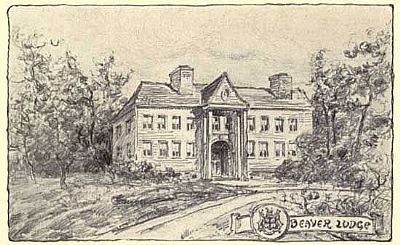
Beaver Lodge/Hall, the home of Joseph Frobisher became a meeting place of the Beaver Club at Montreal. The illustration comes from Masters of the Wilderness, by Charles Reed, 1914. The dining hall could accommodate 40 people, hence the original restriction on membership.
Closed fraternal networking was intensified by the brotherhood of Freemasonry and also by the exclusive Beaver Club in Montreal. These allowed the key wintering partners of the fur trade to mingle profitably in private as well as socially with bankers, traders and politicians based in the city.
The tensions between venturing and investment are well demonstrated in the lives of many of the fur traders.
The essential London trader base and trade rivalry
The key to success was to have a family trader back in Britain sometimes with a branch office in Montreal or Quebec who could market the pelts and return goods to trade with the trappers for the best prices.
At least two rival Grants in London, for example, ensured this traffic across the Atlantic and the North American Continent which made pioneering profitable.
Market competition could turn into bitter, legal and physical battles. Enormous wealth was involved as well as growing political and social status and influence.
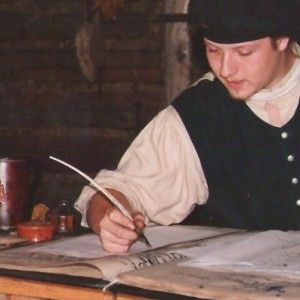
A young re-enactor clerk apparently showing his book-keeping skills. This was how most youngsters from the Strathspey region we know about got their foot on the ladder of management in the fur trade which could culminate in partnership.
The final balance for one year in the NWC book showed a net profit to be shared of £170,647.3s.2d Meticulous accounting of the company's vast fortune at the time is clearly visible in such account books. In that year the NWC profits exceeded those of the HBC.
Rivalry was most intense between the Nor’ Westers (largely a kinship operated and profit-sharing company) and the Astorians (dependent on Jacob Astor’s private fortune) and the Hudson’s Bay Company (backed by Westminster and speculative shareholders).
Rivalry with the landed settlers
Far from being settlers themselves or wanting to encourage others to come to the “new” lands they became quite active in discouraging such ventures because they recognised that their business interests would be irrevocably damaged by this kind of "imposition" on the land.
Integration into the existing communities and creation of a new “Nation”.
Once women folk began to arrive from Britain and after the NWC had been absorbed into the HBC, fur-trade society changed radically. A more settled pattern of social acceptability and marginalisation and subordination was created that still causes much satisfaction for some but many problems for others today.
Women, even in a paternalist society, have always had a profound effect on social "acceptability" for better and for worse, a feminine responsibility which is not always fully acknowledged.
Some of the later traders integrated into the existing society very well and used their canny experience to become leaders in government, banking and commerce. Several can be said to have been part creators of confederated Canada.
The older generation of fur traders, both French and Scottish were also largely responsible for the creation of the Canadian Metis Nation within the Dominion.
There are now three septs of Canadian Grants who share that mixed cultural heritage and who are fully acknowledged by the current Clan chief in Scotland, Sir James Grant of Grant.
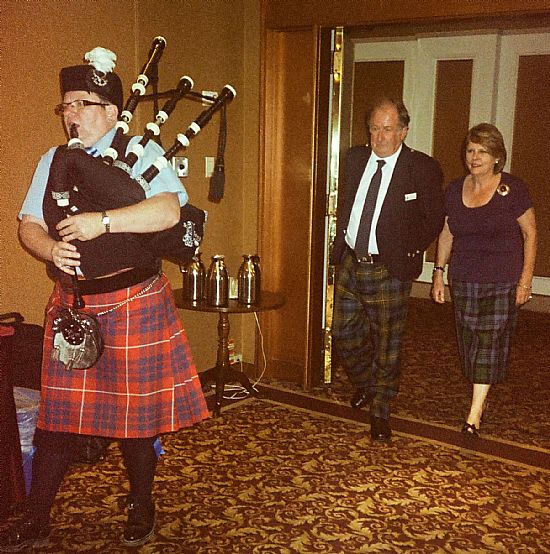
Sir James Grant of Grant, Lord Strathspey and his partner Mrs Judy Lewis being piped in to the dinner in his honour in 2012 in Winnipeg when Sir James installed Anita Steele as the steward of the Macrobbie Grants of Inverlochie.
The legacies of intercultural relations between Scots and other nations is a highly complex, vast and sensitive one and needs to be dealt with even summarily in a seperate page.

